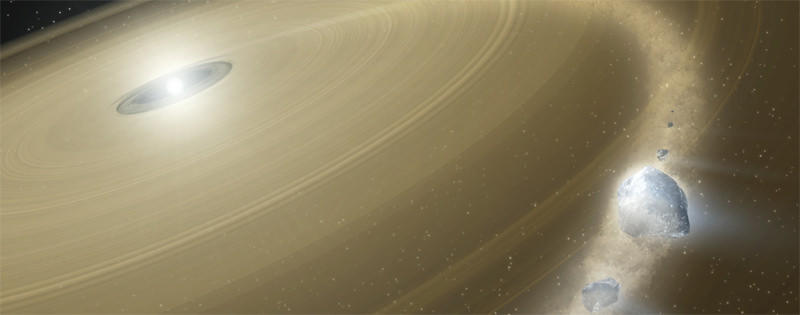[/caption]
The primary method by which astronomers hope to study exoplanet atmospheres is by detecting their absorption spectra as they transit their parent stars. However, another way would be to detect the signal of the atmospheric components in the atmosphere of a star that recently cannibalized a planet or other large body. White dwarfs offer an excellent class of stars on which to use this method since convection will pull heavy elements down more rapidly, leaving surfaces with near pristine hydrogen and helium photospheres. The presence of other elements would indicate recent accretion. This method has been used on several white dwarfs previously, but a new study reexamines data from a 2008 paper, adding their own data on the white dwarf GD61 to propose that the star isn’t just eating dust and small bodies, but a sizable one, likely containing water.
Data for the project were taken in 2009 using the SPITZER telescope. One of the first clues to the presence of a recent case of cannibalism was the presence of warm dust within the Roche limit of the star. This disc did not extend more than 26 stellar radii from the star, leading the team to suspect that this was not simply a large scale disc feeding the star with rocky materials, but an object that had fallen inwards to be tidally torn apart.
To support this, the new team used the Keck I telescope on Mauna Kea with the HIRES spectograph to analyze the spectrum. The findings from this confirmed the previous study that, in order of decreasing abundance, the star contained helium, hydrogen, oxygen, silicon, and iron. Based on the amount of material present in the spectrum and estimated convection rates for such stars, the team concluded that, if the disc were created by a single body, it would have been an asteroid at least 100 km in diameter. So why should the team expect that it was a single body as opposed to many smaller ones?
The key lies in the relative amount of detected elements. For GD61, oxygen was the most abundant element not typically present in white dwarf atmospheres. In fact, its presence far outweighed the other elements such that, even if all of it had been previously bound to the silicon, iron, carbon, and other trace elements, there would still be an inexplicable excess. This oxygen would necessarily have been combined into some molecule or have dissipated during the red giant phase. The only way the team could account for its presence would be to have it wrapped up in water (H2O) which, after disassociation, would allow the hydrogen to blend in the the expected hydrogen already present. Since water readily sublimates without sufficient pressures, the team notes that a large number of small bodies would be unable to bury the water deep enough to keep it from escaping previously, that the best explanation would be a large body which could shield water inside it during the previous red giant phase.
The evidence of water rich asteroids speaks to the formation of our own solar system because it provides a delivery mechanism for water to our planet beyond direct accretion. Water rich asteroids and comets would likely have supplemented our supply. Indeed, Ceres, the largest known asteroid in our solar system, is suspected to harbor as much as 25% of its mass in water.

